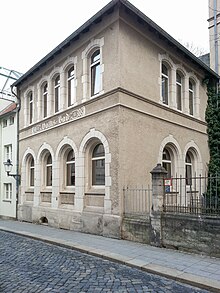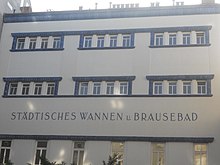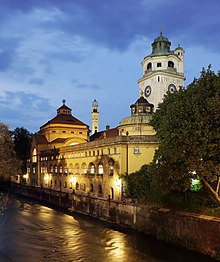Volksbad

A public bath was originally a public bathing establishment with shower or bath tubs, which was intended to offer the lower classes in particular the opportunity for regular personal hygiene. In Bavaria and Austria the common name for it was Tröpferlbad , Volksbrausebad or Brausebad for short . The first public baths appeared in Europe in the mid-19th century, with England leading the way.
There are only a few of the old public baths left in Europe today, most of them elaborately restored swimming pools , often in a classicist or art nouveau style . The old public baths lost their original function, as today almost every apartment has a bathroom , which reduced the need. In addition, the old buildings could not meet the new requirements for swimming pools (such as suitability for sports competitions, wellness offers, etc.). At the same time, the increasing financial hardship led the municipalities to close or convert them (e.g. as a disco or youth facility).
history
The Age of Enlightenment also brought about a rethinking of hygiene in the upper classes , which had previously been largely neglected. Since the majority of the population had no access to running water, not to mention bathing facilities, doctors advocated setting up public bathing establishments. In 1842, the first public laundry and bathing establishment for workers was established in Liverpool, and other cities in England soon followed suit. The first Belgian bathing establishment was in Brussels (1854), the first in Switzerland in Winterthur ( Bad- und Waschanstalt Winterthur , 1864). Meyers Konversationslexikon 1888 describes the Berlin Admiralsgartenbad , a bathing establishment in Bremen and the Bad am Praterstern in Vienna as the most modern facilities of this time.
The first German public bath was built in Hamburg in 1855 at the Schweinemarkt. It had 65 bathtubs and 56 washing stands for washing clothes. The construction was financed with the help of shares and donations from wealthy citizens. In 1860, the first public bathing establishment with a swimming pool opened in Magdeburg . There was the first public bath in Berlin in 1879. Other baths were built in Munich , Augsburg , Darmstadt , Flensburg , Gießen , Kassel , Nuremberg , Coburg , Mannheim and Jena , among others .
The public breakthrough in terms of acceptance of such facilities was achieved by the Berlin dermatologist Oskar Lassar , who founded the Berlin Association for People's Baths in 1874 , whose motto was: “Every German a week a bath!” This meant that there were no tubs, but primarily shower baths meant; today one speaks generally of showering .
The critical success in enforcing the Volksbrausebads came with the Berlin Hygiene Exhibition in 1883. Lassar there had built a total of ten shower stalls for women and men, an 8 x 5 meter corrugated iron shack. During the exhibition everyone could take a shower bath for 10 pfennigs including soap and a towel. The water temperature was only about 28 degrees Celsius, so it was more tepid than warm. The demand was extremely convincing. Between May 10 and July 30, a total of 7,300 people took advantage of the offer.
Meyers Konversationslexikon from 1888 devoted a detailed article to the Volksbrausebad, an absolute novelty at the time:
“The popular shower baths, which are supposed to give the poor folk classes the benefit of health-promoting cleansing baths, have recently become more important. While the public bathing system, which has been in use in England for around 40 years and in Germany for around 35 years, previously only knew shower baths in connection with other types of baths [...], these have only recently emerged as an independent and exclusive form for public bathing establishments, especially since 1883 The hygiene exhibition organized in Berlin [...]. The condition of being able to supply a warm cleaning bath for a price commensurate with the income of the poorer population groups is fulfilled by the shower bath. […]
Cells about 1.5 m long and 1.10 m wide are equipped with a fixed shower for warm water and the like. a hose shower for cold (in women's baths also for warm) water. […] A simple corner seat, above it a clothes rack and a small mirror as well as a soap dish attached near the shower complete the equipment of the cells. This simplicity, but especially the lack of any bathing vessel and thus the opportunity to deposit impurities and infectious agents, make the shower baths an extremely suitable form for public baths, especially from a hygienic point of view. The bathing establishment is formed by amalgamating a large number of cells, and a laundry, [...] toilets and equipment are also part of this. "
The lexicon also reports that two public baths were opened in Berlin in 1888, with 175,998 visits in the first year of operation; However, there were also bathtubs in both institutions. The biggest rush was on Holy Saturday with a total of 2,400 bathers.
Even after the general introduction of running water in the cities, public baths remained an important facility. As before, very few apartments had their own bathroom, at most you could put a bath tub in the laundry room ; However, since the water had to be heated in the washing kettle with wood or coal fire, this was time-consuming and laborious. Private bathrooms were practically only available in the homes of the wealthy. It was only after the Second World War, and initially only in new buildings, that bathrooms slowly gained acceptance in normal apartments.
Drip baths in Vienna
The first public bathing establishment in Austria was the Dianabad in Vienna , built in 1804 ; after the renovation in 1842 it had 104 cabins. There were also three other large baths in the city before 1875. The first real Viennese public baths was the Leopoldstädtische bathing and washing establishment opened in 1855. The first so-called Tröpferlbad was opened on December 22nd, 1887 in Vienna at Mondscheingasse 9, in the courtyard of the former Grundarmenhaus. It was the first European popular shower bath based on the Lassar model, without any tubs. It had 42 bathing stalls for men and 28 for women.
The name Tröpferlbad came up because there were bottlenecks in the water supply when there was a large number of visitors and the water from the showers no longer flowed in streams, but only dribbled. Since there was a shared cloakroom and the showers were open, all users had to wear a so-called bath apron in order to maintain “decency”. The great success led to the opening of two more drip baths in Vienna in 1890. As a result, separate departments for girls and boys were introduced. These four departments existed until 2003.
As a result, a bath was built in almost every district, so that instead of the previously usual high spring water, well water also had to be used. In 1908, the bath in Mondscheingasse was replaced by the Tröpferlbad in Hermanngasse in Vienna's 7th district , which still exists today . 19 public baths were built in the city by the First World War. After a longer break, the program in “Red Vienna” was continued. In 1943 the bathing aprons were dispensed with due to the emergency in the Second World War .
With the increase in the housing standard and the spread of private bathrooms, the number of visitors fell sharply. In 1955 there were 4,713,190 visits, in 1995 only 194,241. After the Volksbad in Geiselbergstraße in Simmering , the Ratschkybad in Meidling and the Weisselbad in Floridsdorf were closed in the mid-2000s , there is only one exclusive drip bath in Vienna today: Volksbad 16 (today "Volksbad Friedrich-Kaiser-Gasse") ) in Ottakring . Shower facilities are still in operation in four other indoor pools and five saunas. The oldest preserved Tröpferlbad is located in Einsiedlergasse in Margareten . It was opened in 1890 and converted into a sauna in 1979.
The Wieden District Museum is housed in a former drip bath that is used there for art exhibitions, among other things.
The Austrian musician duo Pirron and Knapp from the 1950s created a musical memorial with the song “ Im Tröpferlbad ”.
Well-known public baths
Germany
- Old Stadtbad Augsburg
- Bamberg city baths
- Stadtbad Bochum
- Berlin
- Braunschweig
- Chemnitz city baths
- Ernst-Alexandrinen-Volksbad Coburg
- Art Nouveau Bath Darmstadt
- Nordbad Dresden
- Münster-Therme Düsseldorf
- Merkel's swimming pool in Esslingen am Neckar
- Volksbad Flensburg
- Merianbad in Frankfurt am Main
- Stadtbad Halle
- Old city bath Heilbronn
- Volksbad Jena
- Stadtbad Kempten
- Stadtbad Krefeld
- König-Albert-Bad Löbau (Saxony)
- Herschelbad Mannheim
- Volksbad Mönchengladbach
- Müllersches Volksbad Munich
- Tröpferlbad, Thalkirchner Strasse 98, Munich
- Municipal bathing establishment Neuwied
- Volksbad Nuremberg
- Stadtbad Witten
- Wuppertal
- Stadtbad Zittau (oldest still preserved and used city bath in Germany)
- Johannisbad Zwickau (first construction phase from 1869)
Austria
- Stadtbad Dornbirn
- Dianabad (Vienna)
- Amalienbad (Vienna)
- Tröpferlbad Friedrichgasse (Graz) - since 1996 Museum of Perception
- Historical steam bath Salurnerstraße (Innsbruck)
Switzerland
- Bath and laundry facility in Winterthur
- Volksbad St. Gallen
- Basel
- The tram stop of the same name is named after a former "shower bath".
- The last shower bath in Basel (Isteinerstrasse 76) was closed in May 2014 and was popular with older, single people and exhibitors at Basel's goods and service fairs.
- At Claragraben 96 there is a shower bath, which was built according to plans by Carl Leisinger and converted into a kindergarten in 1946.
France
See also
literature
- Sylvia Mattl-Wurm , Ursula Storch (Red.): The bathroom. Physical culture and hygiene in the 19th and 20th centuries (= Historical Museum of the City of Vienna. Special exhibition. 142, ZDB -ID 881004-7 ). Museums of the City of Vienna, Vienna 1991.
- Carolin Ruther: Clean & healthy! The German hygiene and public bathing movement and the old city bath in Augsburg. Marburg: Tectum 2014.
- Stefan Winterstein: A city's getting used to swimming. On the history of the Wiener Volksbad program. In: Viennese history sheets. 60, 4, 2005, ISSN 0043-5317 , pp. 1-14.
Web links
- Report on the last three public bathtubs in Berlin
- Report about the Volksbad Nürnberg on geschichtsspuren.de (formerly lostplaces.de)
- History of the drip baths in Vienna
- Basler Zeitung: The last shower in the city. - Report on the shower bath, which was closed in 2014, at Isteinerstrasse 76 in Basel.
Individual evidence
- ↑ Beer garden | The bath at Theresienwiese | Munich. Retrieved January 18, 2019 .
- ^ Volksbad Friedrich-Kaiser-Gasse - the city of Vienna's shower bath. Retrieved December 12, 2019 .
- ↑ Sauna baths and shower baths of the City of Vienna
- ↑ Bezirkszeitung - district edition Margareten, edition 20/2008, p. 2.
- ↑ Blickpunkt Geschichte ( Memento of the original from July 29, 2016 in the Internet Archive ) Info: The archive link was inserted automatically and has not yet been checked. Please check the original and archive link according to the instructions and then remove this notice. , via the Stadtbad Zittau, last accessed in June 2012.
- ↑ The history of the cultural monument "Johannisbad" ( Memento of the original from June 17, 2012 in the Internet Archive ) Info: The archive link was inserted automatically and has not yet been checked. Please check the original and archive link according to the instructions and then remove this notice. , last accessed in June 2012.
- ↑ http://www.badi-info.ch/sauna/bs_basel_isteiner.htm (accessed on December 20, 2014)
- ↑ http://bazonline.ch/basel/stadt/Das-letzt-Brausebad-der-Stadt/story/26096798 (accessed on May 15, 2017)









